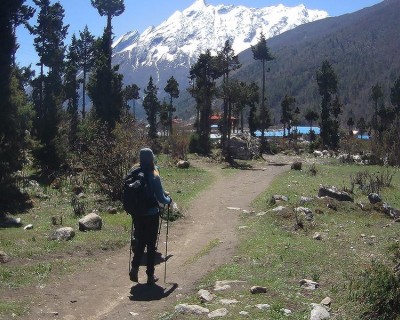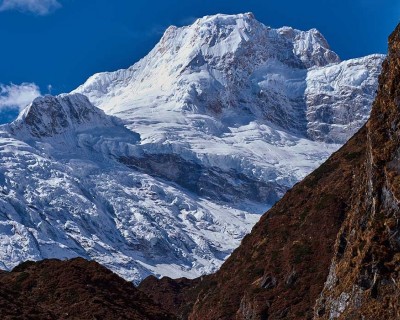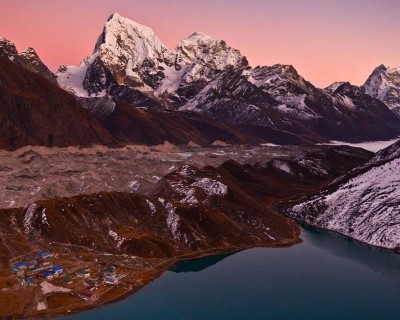The Everest Base Camp trek 12 Days Itinerary is a challenging and memorable journey through some of the most breathtaking scenery on earth. If you are lucky, you can witness a range of plants and animals, including the elusive snow leopard in the Sagarmatha National Park on your journey that begins in the small town of Lukla.
One of the main highlights of the trek is reaching the base station, which is located at a height of 5,364 meters. You can enjoy the view of The Khumbu Glacier and the nearby peaks, such as Lhotse, Nuptse, and Mount Everest.
You wouldn't want to miss these attractions. So, we suggest the Everest Camp Trek in November.
Well, for the basics, the best weather in the Himalayas in November tops the list of answers. And, who wouldn't want to enjoy the magical views of snow-capped mountains, lush hilly landscapes, and expansive meadows?
Now, let's dig deeper and find out why the month of November?
Reasons for Everest Base Camp Trek in November
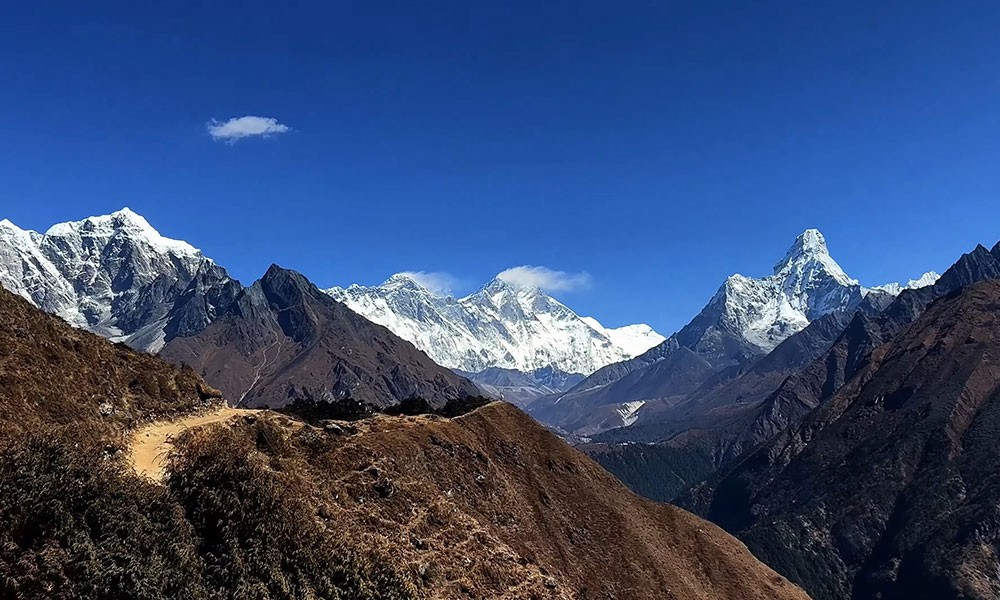 Clear Blue Sky
Clear Blue Sky
November is the month of the transition of seasons here in Nepal. As autumn is at its end, ready to welcome winter, the sky gets clearer than ever. Moreover, little rainfall and snowfall allow the trekkers to enjoy unrestricted views of the breathtaking Himalayan scenery.
Mild Temperature
November days are typically mild in temperature, making it simpler to hike for several hours each day. The nighttime temperatures are also not as chilly as they can be in the winter. Hence, trekkers won't have to worry about numb hands and feet due to cold.
Consistent Weather
One of the most disheartening things during treks to base camps can be unpredictable weather conditions. However, the Everest Base Camp Trek in November saves you from it. There are fewer possibilities of flight cancellations or delays in November because of the stable weather.
Less Crowd
As said earlier, the Everest Base Camp attracts thousands of tourists annually. The busiest months for the trekkers and climbers in the Everest Base Camp is September, October, March, April, and May. While November is also a great time for many trekkers, avoiding the crowds that swarm to the Everest Base Camp during the busiest trekking seasons is easy in November. Trekkers can experience a more quiet and laid-back journey.
Cultural Experiences
Trekking in November in Nepal allows hikers to participate in the Mani Rimdu festival, a traditional celebration held by the Sherpa community. This festival is typically held in the Tengboche Monastery, located in the Everest region of Nepal, during the tenth lunar month of the Tibetan calendar, which usually falls in November.
Beautiful Landscapes
Everest Base Camp Trek in November offers trekkers a unique opportunity to experience the stunning landscapes of the Everest region at its best, as it is when the fall foliage and snow-capped peaks are at their peak. As the trek gradually gains altitude, trekkers are treated to panoramic views of snow-capped peaks, including Mount Everest, Lhotse, and Nuptse. Most of it is because of the perfect weather condition in November.
Availability of accommodation
Finding appropriate lodging during the busy trekking season is one of the major difficulties trekkers encounter. However, going on the Everest Base Camp Trek in November means fewer trekkers are on the trail. Hence, there is a greater chance of finding suitable accommodation opportunities in the trial lodges in November.
Overall, November offers a unique opportunity to experience the beauty and majesty of the Himalayas in a peaceful and relaxed environment. With its clear skies, mild temperatures, and beautiful landscapes, it's no wonder that the Everest Base Camp Trek in November is a great deal for trekkers.
Weather Around Everest Base Camp in November
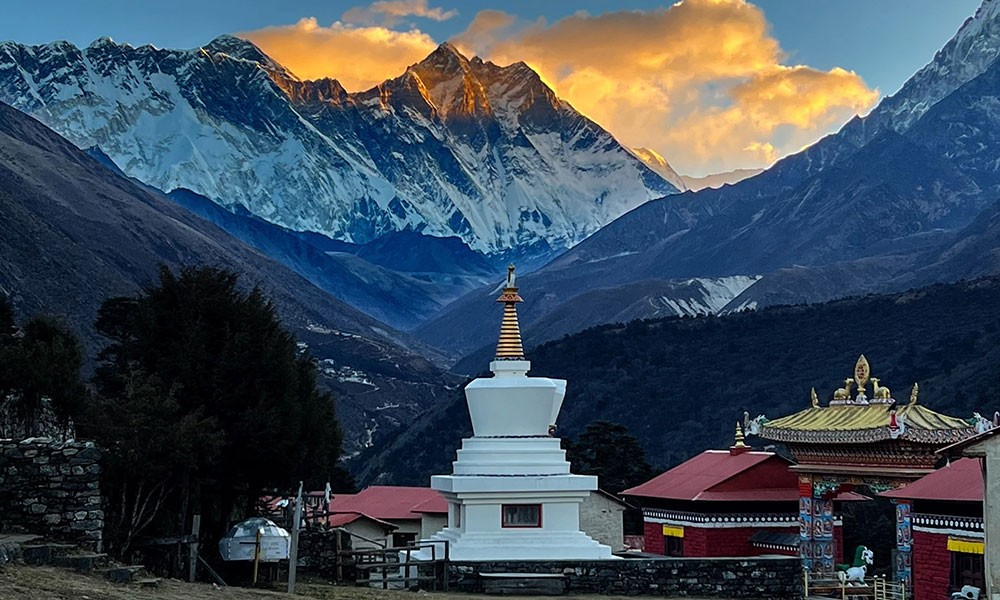 With little to no rainfall, November marks the beginning of the dry season in the Everest area. Since the sky is typically clear, taking a clear view of the breathtaking Himalayan landscapes is simpler. However, it can get chilly, with daytime temperatures of -5 to 15 degrees Celsius and nighttime temperatures of -20 degrees Celsius. Therefore, bringing the appropriate equipment on the trek is crucial to stay warm and comfy.
With little to no rainfall, November marks the beginning of the dry season in the Everest area. Since the sky is typically clear, taking a clear view of the breathtaking Himalayan landscapes is simpler. However, it can get chilly, with daytime temperatures of -5 to 15 degrees Celsius and nighttime temperatures of -20 degrees Celsius. Therefore, bringing the appropriate equipment on the trek is crucial to stay warm and comfy.
Snowfall that is light to moderate is to be expected during the first part of November for hikers. Snow accumulation on the paths can make them slick and difficult to trek on. However, the snow enhances the landscape's majesty and fosters a meditative and magical atmosphere. As the month progresses, it becomes easier to trek as the snow gradually melts away.
The temperature throughout the journey can vary depending on the location during November.
See also: Everest Base Camp Trek Weather
Trail to follow for November Trek to Everest Base Camp
Well, as mentioned earlier, November is the transitional month in Nepal. Even though this month is great for you to set out on Everest Base Camp Trek, some routes are best to avoid, especially if you are new to trekking.
Experts say that it is a smart move to avoid the tougher routes like the Three High Passes trek. However, don't worry! We have other trails that you can choose from. And trust us; these trials have nothing less to offer. They are even easier and equally beautiful.
Now, let's look into the areas you cover during your Everest Base Camp Trek in November.
Arrival in Kathmandu
The first step of the Everest Base Camp trek is to arrive in Kathmandu, the capital city of Nepal. You can take a direct flight to Kathmandu from major international airports if you are an international trekker. And, for Nepalese, you can fly to Lukla from anywhere comfortable.
Flight to Lukla
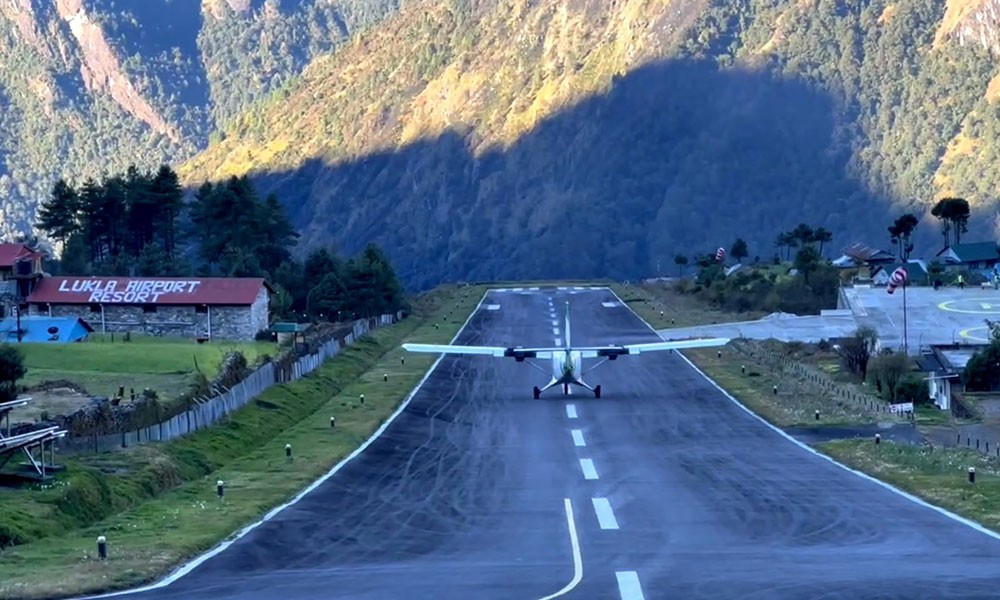 The next step is to take a flight from Kathmandu to Lukla, the starting point of the trek. The flight is scenic and adventurous, as the plane lands on a narrow runway at 2800 meters. People say the flight can give you chills.
The next step is to take a flight from Kathmandu to Lukla, the starting point of the trek. The flight is scenic and adventurous, as the plane lands on a narrow runway at 2800 meters. People say the flight can give you chills.
Trek to Phakding
The trek starts from Lukla, and the first destination is Phakding. The trek is relatively easy and takes around 3-4 hours. You will walk through beautiful villages and dense forests and cross suspension bridges over the Dudh Koshi river.
Trek to Namche Bazaar
Namche Bazaar is the largest village in Khumbu at an altitude of 3,440 meters and is also known as the gateway to Mount Everest. The trek from Phakding to Namche Bazaar is challenging and takes 6-7 hours. You will cross the famous Hillary suspension bridge and climb uphill to Namche Bazaar.
Rest day in Namche Bazaar
It is essential to acclimatize to the altitude before going higher. So, spending a day in Namche Bazaar is recommended to adjust to the height. You can explore the village, visit the local market, and hike to the Everest View Hotel for stunning views of Mount Everest.
Trek to Tengboche
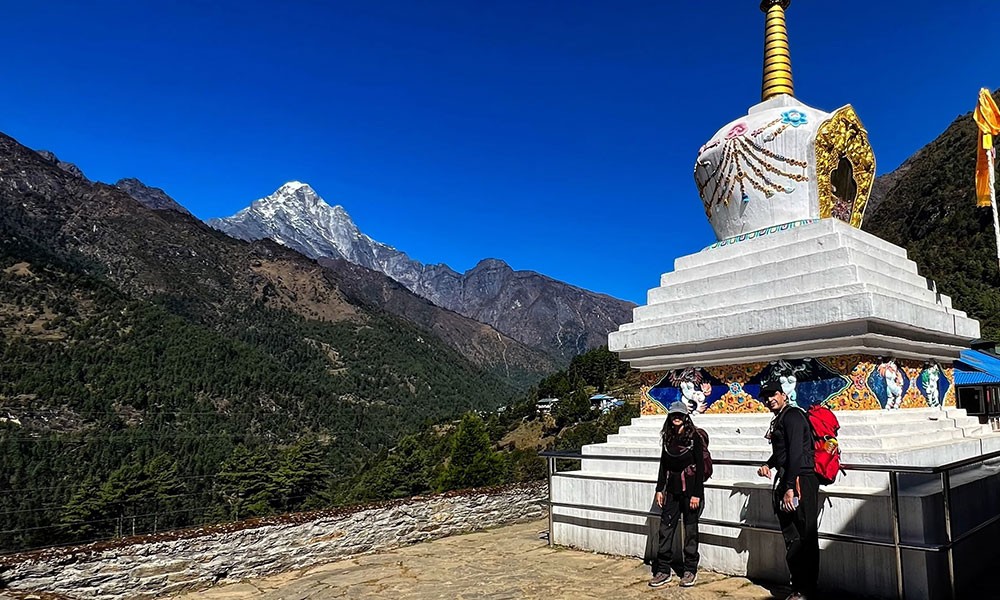 The trek from Namche Bazaar to Tengboche is a scenic one, with spectacular views of the Himalayas. You will walk through the rhododendron forests and cross suspension bridges over the Imja Khola river. Tengboche is famous for its monastery, which is the largest in the Khumbu region.
The trek from Namche Bazaar to Tengboche is a scenic one, with spectacular views of the Himalayas. You will walk through the rhododendron forests and cross suspension bridges over the Imja Khola river. Tengboche is famous for its monastery, which is the largest in the Khumbu region.
Trek to Dingboche
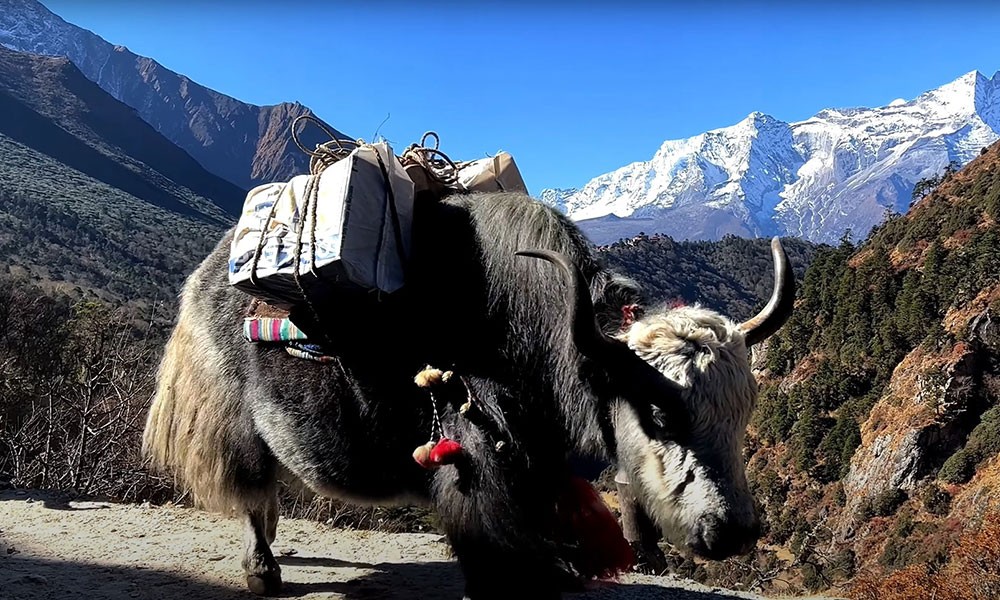 The trek from Tengboche to Dingboche, a small village at an altitude of 4,410 meters, is challenging, as you will gain a significant altitude. You will walk through the Imja Khola valley and cross several suspension bridges. Dingboche is a beautiful village surrounded by mountains and a popular trekking stop.
The trek from Tengboche to Dingboche, a small village at an altitude of 4,410 meters, is challenging, as you will gain a significant altitude. You will walk through the Imja Khola valley and cross several suspension bridges. Dingboche is a beautiful village surrounded by mountains and a popular trekking stop.
Rest day in Dingboche
It is crucial to acclimate to the altitude before going higher, so spending a day in Dingboche is recommended. You can explore the village, visit the local bakery, and hike to Nangkartshang Peak for stunning views of the Himalayas.
Trek to Lobuche
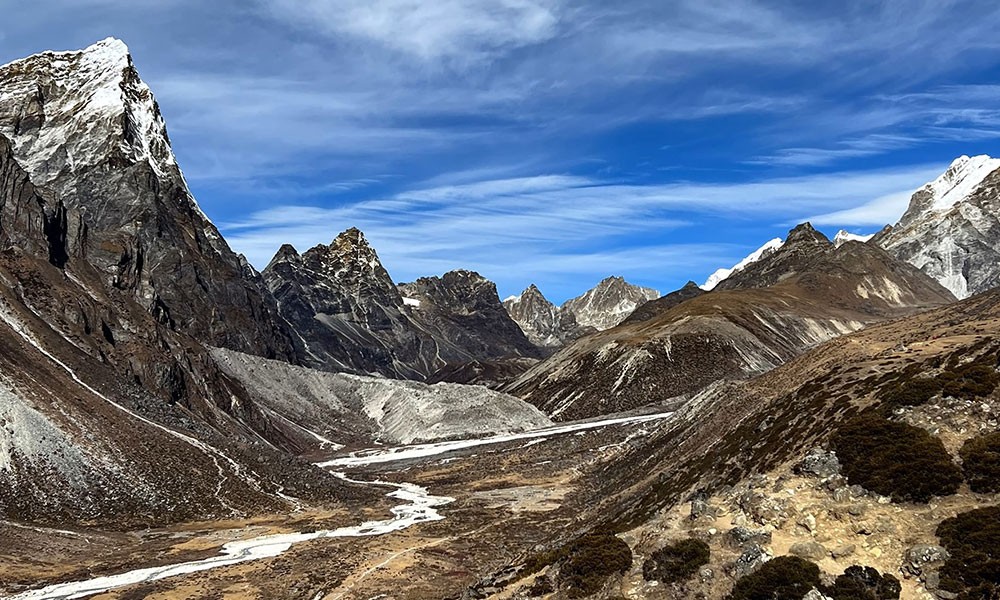 The trek from Dingboche to Lobuche will take you through another small village at an altitude of 4910 meters. You will walk through the Khumbu glacier and witness the memorials of the climbers who lost their lives on Mount Everest.
The trek from Dingboche to Lobuche will take you through another small village at an altitude of 4910 meters. You will walk through the Khumbu glacier and witness the memorials of the climbers who lost their lives on Mount Everest.
Trek to Gorak Shep
The trek from Lobuche to Gorak Shep is short, and it takes around 3-4 hours. You will reach Gorak Shep, the last settlement before the base camp, at an altitude of 5160 meters.
Hike to Everest Base Camp
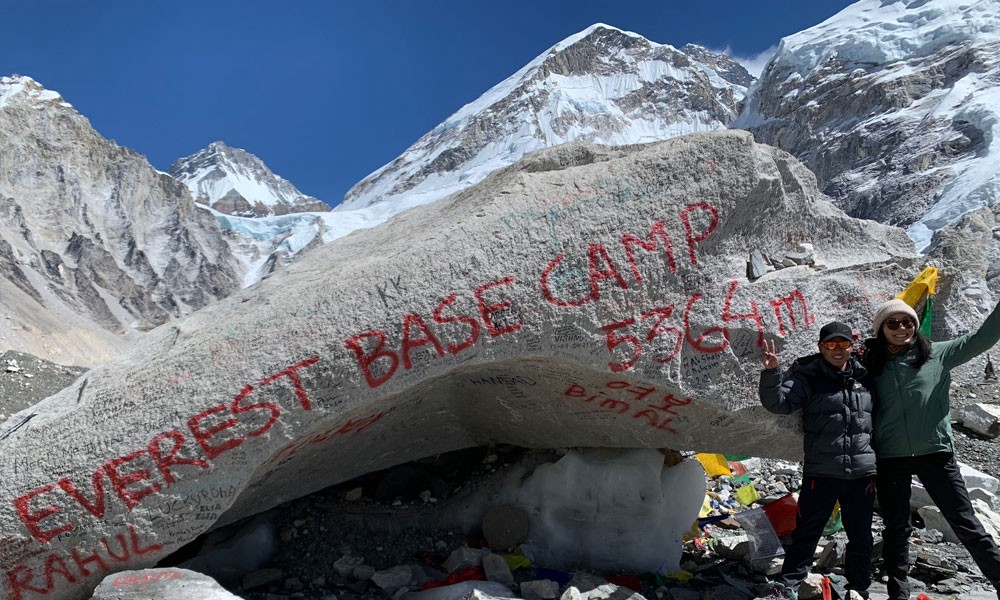
On day 9, you'll hike to Everest Base Camp at 5,364 meters. The hike is challenging and takes around 3-4 hours.
Return to Gorak Shep
After reaching Everest Base Camp, you'll return to Gorak Shep for the night.
Hike to Kala Patthar
On day 10, you'll hike to Kala Patthar, a peak of 5,545 meters. You'll get an incredible view of Mount Everest and the surrounding Himalayas from the top.
Return to Lukla
After completing the trek, you'll trek back to Lukla over the course of several days. The return trek follows the same route as the outbound trek.
Fly back to Kathmandu
From Lukla, you'll fly back to Kathmandu, marking the end of your trek to Everest Base Camp.
The trail can sometimes be challenging, but the beautiful journey is worth the challenges. Also, Marvel Adventures is always at your service to make your trip easier and more comfortable.
We offer you a great choice of packages and great professional guides to take you through the mesmerizing Everest Base Camp Trek in November.
Guides and Porters for Everest Base Camp Trek in November
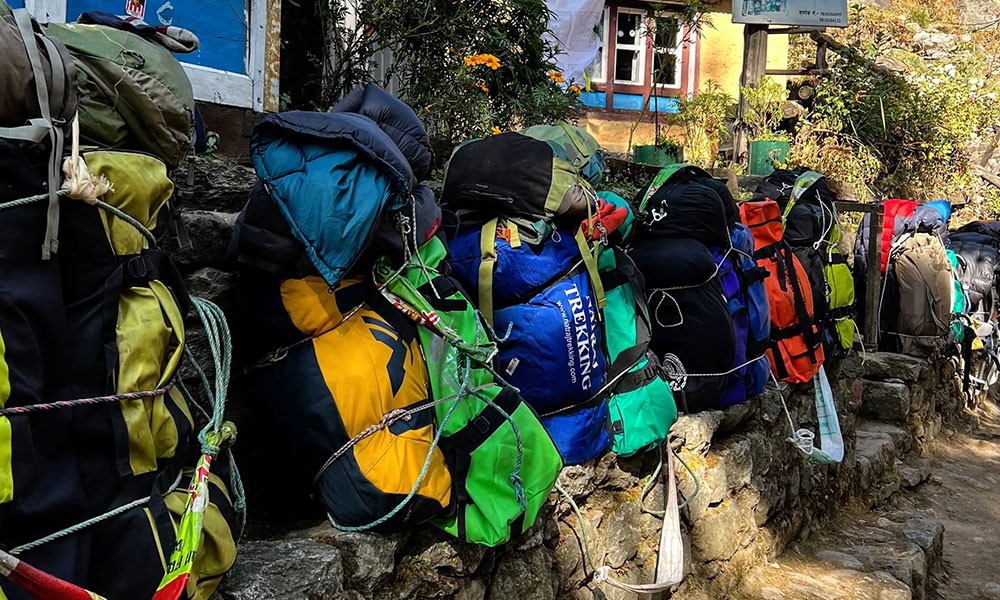 Well, as per the rule by Nepal's government, you cannot trek to the Everest Base Camp without professional guides.
Well, as per the rule by Nepal's government, you cannot trek to the Everest Base Camp without professional guides.
Additionally, having our professional guides lead the way can make your journey more informative. You will get the chance to learn more about the local community alongside enjoying the natural beauty.
Also, having porters carry your gear lessens your burden. The gears that you need for Everest Base Camp Trek can be heavy. Porters will not only assist you with your bags, but they will also make things entertaining as guides do.
Nevertheless, you should choose professional guides and porters before starting the journey. You can select a trustworthy agency for that.
Marvel Adventures provides trained guides and porters. If you choose us, we will provide you with our best services when it comes to guides and porters.
Cost for Everest Base Camp Trek in November
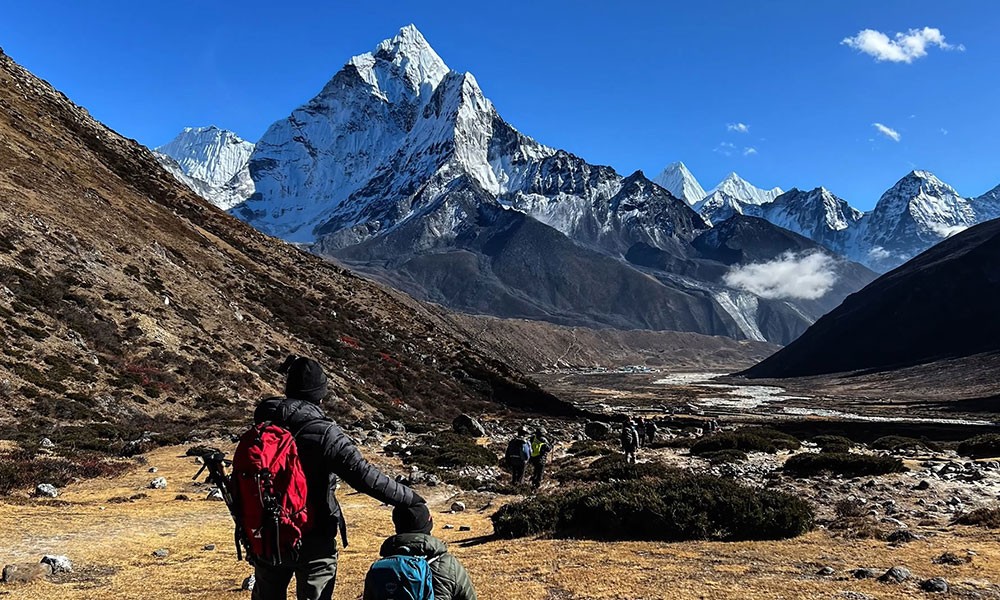 The Everest Base Camp trek is a popular bucket-list adventure for many, offering stunning views of the Himalayas and an opportunity to challenge oneself physically and mentally. However, with this experience comes a cost, and planning and budgeting are important.
The Everest Base Camp trek is a popular bucket-list adventure for many, offering stunning views of the Himalayas and an opportunity to challenge oneself physically and mentally. However, with this experience comes a cost, and planning and budgeting are important.
So, let's explore the costs of trekking to the Everest Base Camp in November.
First and foremost, the cost of the trek depends on the mode of transportation. The most common way to reach the starting point of the trek, Lukla, is by flight. The flight from Kathmandu to Lukla can cost between $150 to $500, depending on the airline and availability. During peak season, prices can be higher, and it is important to book in advance to secure a spot.
The trekking permit is the next major cost associated with the Everest Base Camp trek. All trekkers must obtain a trekking permit and a Sagarmatha National Park permit to enter the Everest region. The cost for these permits varies depending on the season. In November, a trekking permit costs $30 per person per week, while the Sagarmatha National Park permit costs $34 per person. Therefore, the permit costs around $128 per person for a two-week trek.
Accommodation and food are other major expenses during the trek. The trek route has numerous tea houses and lodges, where trekkers can find basic accommodation and food. A basic room can range from $5 to $30 per night, depending on the location and the amenities. Meals cost around $5 to $10 per meal, depending on the location and the menu. The cost of accommodation and food can add up quickly, and it is important to budget accordingly.
Other Everest Base Camp trek costs include hiring a guide or porter, equipment rental, and travel insurance. Hiring a guide or porter is optional but can make the trekking experience more enjoyable and safer. A guide can range from $25 to $35 per day, while a porter can cost around $15 to $20 per day. Equipment rentals, such as trekking poles, sleeping bags, and jackets, can cost around $1 to $3 per day. Travel insurance is essential, and purchasing a policy covering high-altitude trekking is important. The cost of travel insurance varies depending on the coverage and duration of the policy.
The Everest Base Camp trek in November can range from $1,000 to $2,000 per person, depending on the mode of transportation, accommodation, food, and other expenses. It is important to budget and plans accordingly, considering any unforeseen expenses, such as flight cancellations or changes in the itinerary due to weather conditions.
Despite the cost, trekking to the Everest Base Camp in November is a unique and rewarding experience. With clear skies, snow-capped peaks, and fall foliage, the landscapes are nothing short of breathtaking. Moreover, trekking during the low season means fewer crowds on the trails, providing a more peaceful and immersive trekking experience.
Gears to Carry for Everest Base Camp Trek in November
The Everest Base Camp Trek is a once-in-a-lifetime adventure that requires careful planning and preparation. November is a great time to embark on this trek, as the weather is clear and dry, and the crowds are thin. However, ensuring you have the right gear to keep you safe and comfortable during your journey is important. Here are some essential items to pack for your Everest Base Camp Trek in November.
Warm Clothing
The temperatures in the Himalayas can drop drastically, especially at night. Packaging warm clothes that will keep you comfortable and protected from the cold is crucial. You'll need a thick-down jacket, a fleece jacket, thermal underwear, woolen socks, a beanie, and gloves.
Hiking Boots
You'll be trekking through challenging terrain, so it's important to have sturdy, comfortable hiking boots that will provide good support and traction. Ensure your boots are well-worn and broken before you begin your trek.
Sleeping Bag
You'll spend your nights in tea houses along the trek, which can get chilly. A good quality sleeping bag will help keep you warm and comfortable during your stay. Look for a sleeping bag rated to at least -10°C.
Trekking Poles
Trekking poles are essential for the Everest Base Camp Trek. They provide stability and support on steep inclines and uneven terrain. They also help reduce the impact on your joints and can help prevent injuries.
Sunglasses
The sun's rays can be quite strong at higher altitudes, so it's important to have a good pair of sunglasses to protect your eyes from UV rays and glare. Look for sunglasses with polarized lenses that will reduce glare and improve visibility.
Headlamp
A headlamp is essential for navigating the tea houses and trails after dark. Bring extra batteries and keep your headlamp in your sleeping bag to prevent it from freezing.
First Aid Kit
It's always a good idea to carry a basic first aid kit with bandages, antiseptic, pain relievers, and blister treatment. You may also want to pack altitude sickness medication, as this can be a concern on the trek.
Backpack
A sturdy, comfortable backpack is essential for carrying your gear and supplies during the trek. Look for a backpack that's lightweight, waterproof, and has a good suspension system.
Camera
Finally, don't forget to bring a camera to capture the stunning views and memories of your Everest Base Camp Trek. Pack extra batteries and memory cards, as you won't want to miss a single moment.
The Everest Base Camp Trek is an adventure of a lifetime, and with the righ gear, you can enjoy it comfortably and safely. Pack warm clothing, sturdy hiking boots, a sleeping bag, trekking poles, sunglasses, a headlamp, a first aid kit, a water purification system, a backpack, and a camera. With these essential items, you'll be prepared to tackle the challenging terrain and make unforgettable memories on your trek.
Difficulties Along The Way
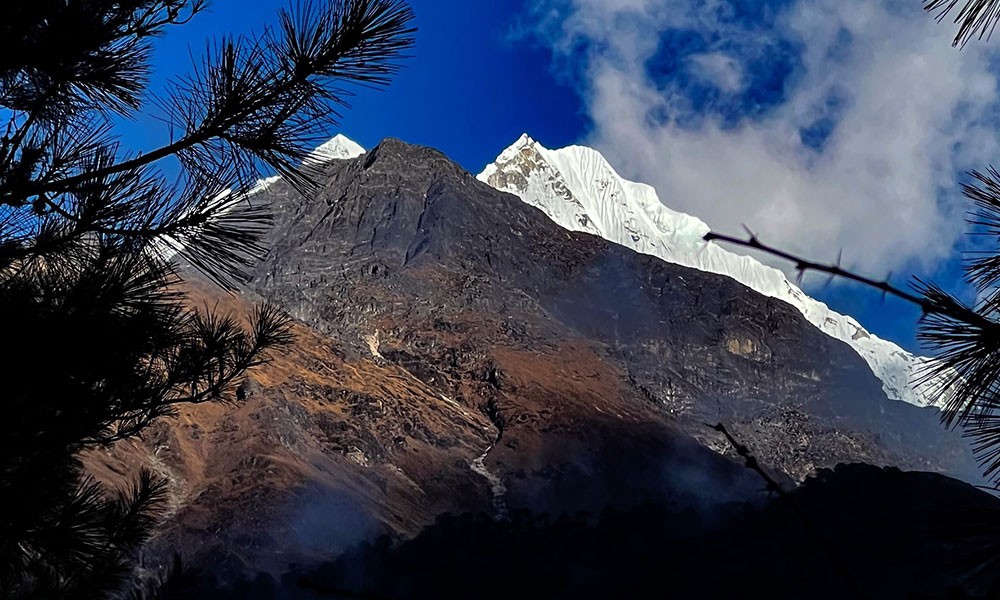 The Everest Base Camp Trek is a challenging and rewarding adventure that requires physical fitness, mental endurance, and careful preparation. Here are some difficulties you can face during the Everest Base Camp Trek in November.
The Everest Base Camp Trek is a challenging and rewarding adventure that requires physical fitness, mental endurance, and careful preparation. Here are some difficulties you can face during the Everest Base Camp Trek in November.
Weather Conditions
November is considered one of the best months to trek to Everest Base Camp, as the weather is usually clear and dry. However, it can still be cold and unpredictable, ranging from -10°C to 15°C.
Altitude Sickness
Altitude sickness is a common problem during the trek, especially as you gain altitude. Symptoms include headache, dizziness, nausea, and shortness of breath. Resting properly is important, which means taking rest days, staying hydrated, and avoiding alcohol and smoking.
Challenging Terrain
You'll trek through steep inclines, rocky paths, and narrow trails. The trail can also be crowded, especially during peak season, making it difficult to pass other trekkers.
Accommodation
Accommodation along the trek is basic and limited, especially in high-altitude regions. Tea houses are the most common type of accommodation, and they can get crowded and noisy even though the number of trekkers is comparatively less in November. It's important to book in advance and carry a good quality sleeping bag and a warm jacket to stay comfortable at night.
Sanitation and Hygiene
Sanitation and hygiene can be a concern during the trek, especially in tea houses and campgrounds. Toilets can be basic and unhygienic, and there's a risk of water-borne illnesses. Carrying hand sanitizer, toilet paper, and water purification tablets is important to maintain good hygiene.
Logistics and Planning
Planning the Everest Base Camp Trek can be a logistical nightmare, especially if you're traveling independently. You must arrange permits, transportation, accommodation, and guides. Researching and planning your itinerary in advance is important to avoid any last-minute surprises. Also, hiring a trustworthy travel agent like Marvel Adventures can be a great idea.
Physical and Mental Endurance
The Everest Base Camp Trek is physically and mentally demanding. You'll walk for several hours daily, carry a backpack, and face altitude and weather challenges. Training and preparing yourself mentally and physically before embarking on the trek is important.
You may like:
Conclusion
Despite all the challenges, trekking to the Everest Base Camp in November offers a unique opportunity to witness the beauty of the Himalayas in a peaceful and relaxed environment. With clear skies, snow-capped peaks, and fall foliage, the landscapes are nothing short of breathtaking. Moreover, trekking during the low season means fewer crowds on the trails, providing a more peaceful and immersive trekking experience.
In conclusion, the Everest Base Camp Trek in November can be challenging for some, but with proper planning and preparation, it is possible to have an unforgettable trekking experience. Packaging the right gear, being prepared for sudden weather changes, and resting properly to avoid any health complications is essential. With clear skies, snow-capped peaks, and fall foliage, the Everest Base Camp trek in November offers a unique opportunity to witness the beauty of the Himalayas in all its glory.
If you decide to embark on this journey, Marvel Adventure Trek is always at your service.


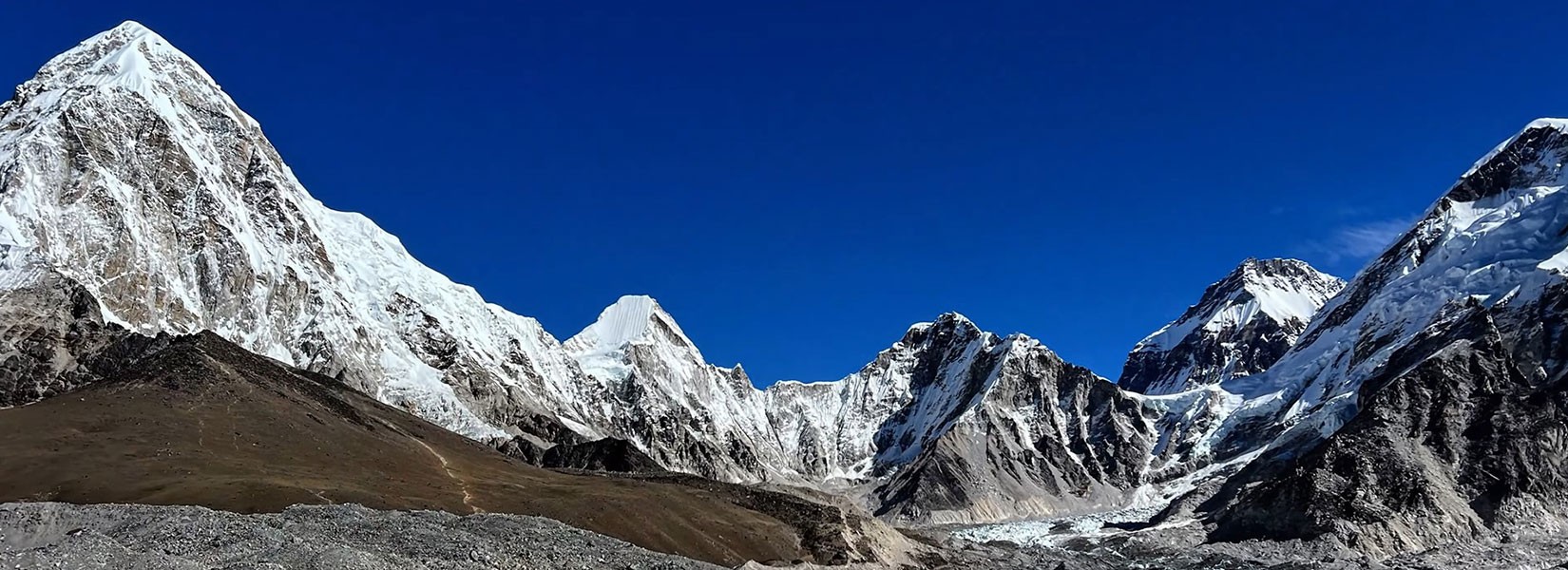

 Clear Blue Sky
Clear Blue Sky With little to no rainfall, November marks the beginning of the dry season in the Everest area. Since the sky is typically clear, taking a clear view of the breathtaking Himalayan landscapes is simpler. However, it can get chilly, with daytime temperatures of -5 to 15 degrees Celsius and nighttime temperatures of -20 degrees Celsius. Therefore, bringing the appropriate equipment on the trek is crucial to stay warm and comfy.
With little to no rainfall, November marks the beginning of the dry season in the Everest area. Since the sky is typically clear, taking a clear view of the breathtaking Himalayan landscapes is simpler. However, it can get chilly, with daytime temperatures of -5 to 15 degrees Celsius and nighttime temperatures of -20 degrees Celsius. Therefore, bringing the appropriate equipment on the trek is crucial to stay warm and comfy. The next step is to take a flight from Kathmandu to Lukla, the starting point of the trek. The flight is scenic and adventurous, as the plane lands on a narrow runway at 2800 meters. People say the flight can give you chills.
The next step is to take a flight from Kathmandu to Lukla, the starting point of the trek. The flight is scenic and adventurous, as the plane lands on a narrow runway at 2800 meters. People say the flight can give you chills. The trek from Namche Bazaar to Tengboche is a scenic one, with spectacular views of the Himalayas. You will walk through the rhododendron forests and cross suspension bridges over the Imja Khola river. Tengboche is famous for its monastery, which is the largest in the Khumbu region.
The trek from Namche Bazaar to Tengboche is a scenic one, with spectacular views of the Himalayas. You will walk through the rhododendron forests and cross suspension bridges over the Imja Khola river. Tengboche is famous for its monastery, which is the largest in the Khumbu region. The trek from Tengboche to Dingboche, a small village at an altitude of 4,410 meters, is challenging, as you will gain a significant altitude. You will walk through the Imja Khola valley and cross several suspension bridges. Dingboche is a beautiful village surrounded by mountains and a popular trekking stop.
The trek from Tengboche to Dingboche, a small village at an altitude of 4,410 meters, is challenging, as you will gain a significant altitude. You will walk through the Imja Khola valley and cross several suspension bridges. Dingboche is a beautiful village surrounded by mountains and a popular trekking stop. The trek from Dingboche to Lobuche will take you through another small village at an altitude of 4910 meters. You will walk through the Khumbu glacier and witness the memorials of the climbers who lost their lives on Mount Everest.
The trek from Dingboche to Lobuche will take you through another small village at an altitude of 4910 meters. You will walk through the Khumbu glacier and witness the memorials of the climbers who lost their lives on Mount Everest.
 Well, as per the rule by Nepal's government, you cannot trek to the Everest Base Camp without professional guides.
Well, as per the rule by Nepal's government, you cannot trek to the Everest Base Camp without professional guides. The Everest Base Camp trek is a popular bucket-list adventure for many, offering stunning views of the Himalayas and an opportunity to challenge oneself physically and mentally. However, with this experience comes a cost, and planning and budgeting are important.
The Everest Base Camp trek is a popular bucket-list adventure for many, offering stunning views of the Himalayas and an opportunity to challenge oneself physically and mentally. However, with this experience comes a cost, and planning and budgeting are important. The Everest Base Camp Trek is a challenging and rewarding adventure that requires physical fitness, mental endurance, and careful preparation. Here are some
The Everest Base Camp Trek is a challenging and rewarding adventure that requires physical fitness, mental endurance, and careful preparation. Here are some 